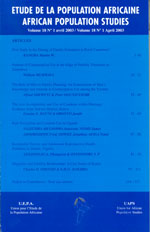
|
African Population Studies
Union for African Population Studies
ISSN: 0850-5780
Vol. 29, No. 1, 2015, pp. 1472-1482
|
 Bioline Code: ep15002
Bioline Code: ep15002
Full paper language: English
Document type: Research Article
Document available free of charge
|
|
|
African Population Studies, Vol. 29, No. 1, 2015, pp. 1472-1482
| fr |
Habyarimana, F.; Zewotir, T. & Ramroop, S.
Résumé
L’utilisation de l’indice d’actifs du ménage dans le ciblage de la pauvreté est une technique moderne. Nous avons utilisé l’analyse en composantes principales pour créer l’indice d’actifs du ménage. Ensuite, l’indice d’actifs du ménage a été utilisé pour évaluer le statut socio-économique des ménages. La fiabilité de l’indice a été testée en vérifiant tout d’abord si l’indice a une cohérence interne, d’autre part la robustesse a été testée à l’aide de sous-indices d’infrastructures de logement et de propriété. La méthode est appliquée en utilisant les données d’enquêtes auprès des ménages au Rwanda. L’analyse des données a montré qu’au Rwanda, l’âge du chef de ménage, son niveau d’étude, son genre, sa province, son lieu de résidence et la taille du ménage étaient les facteurs prédictifs significatifs de pauvreté du ménage au Rwanda.
Mots Clés
Agrégation; composantes principales; objectif du millénaire; odds ratio; réduction de la pauvreté
|
| |
| en |
Analysis of demographic and health survey to measure poverty of household in Rwanda
Habyarimana, F.; Zewotir, T. & Ramroop, S.
Abstract
The use of the asset index in poverty targeting is a modern technique. We used the principal component analysis (PCA) technique in order to create the asset index. Then the asset index was used to assess the socio-economic status (SES) of households. The reliability of the index was tested firstly by ascertaining whether the index was internally coherent, secondly the robustness was tested using the sub-indices such as housing infrastructure and ownership. The methodology is applied and demonstrated using the household survey data in Rwanda. The Rwanda data analysis showed that the age of household head, education level of the household head, gender of the household head, place of residence, the province of household head and size of the household (number of household members) were the significant predictors of poverty of the household in Rwanda.
Keywords
Clumping; millennium goal; odds ratio; poverty reduction; principal component
|
| |
© Copyright 2015 - African Population Studies
Alternative site location: http://www.uaps-uepa.org
|
|
